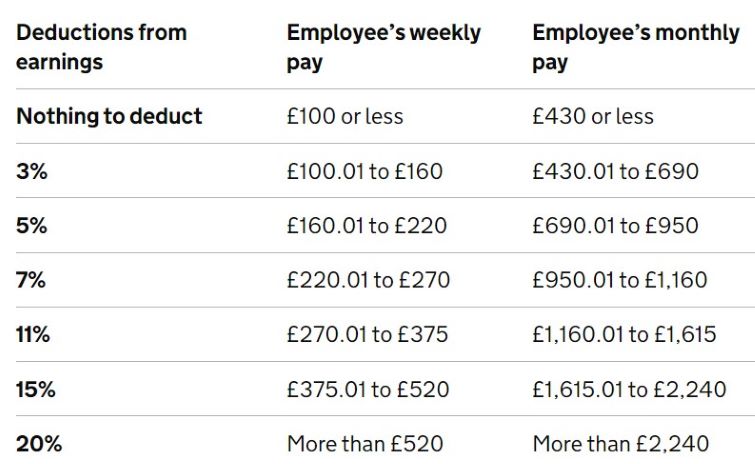Understanding direct earnings attachment: Your essential guide to employer obligations and employee rights
Are you facing a direct earnings attachment on your paycheck or tasked with implementing one as an employer? This article cuts through the complexity, outlining the must-know facts about DEAs, employer responsibilities, and employee protections.
Overview:
- Decoding direct earnings attachment (DEA)
- The role of employers in administering DEAs
- Types of earnings subject to DEA
- Protecting the employee: Understanding protected earnings
- Navigating multiple deductions: Prioritising DEAs among other debts
- Illustrating DEA in action: Case study analysis
- Coping with benefit debt deductions: Strategies for employees
Decoding direct earnings attachment (DEA)
At the heart of DEAs lies a simple principle: the recovery of benefit overpayments directly from an individual’s earnings.
You might wonder about the legality of this mechanism.
Well, it’s authorised under the Welfare Reform Act 2012, which empowers the Department for Work and Pensions (DWP) to request employers to operate a DEA without the need for a court order.
Unlike other deduction orders, such as an Attachment of Earnings Order (AEO), DEAs bypass the necessity of going through the civil courts.
So, what benefits does the DWP recover through DEAs?
The list includes:
- Jobseeker’s Allowance
- Employment and Support Allowance
- Working Tax Credit
- Universal Credit
- Child Benefit
These regulations have been in effect since April 8, 2013, helping the DWP reclaim overpayments and balance the financial ecosystem.
Get in touch with one of Sleek’s many experts today!
The role of employers in administering DEAs
The administration of DEAs heavily relies on employers.
They must navigate calculations, deductions, and compliance, ensuring that the process runs smoothly and transparently.
We should explore further the roles and responsibilities of local authorities.
Deduction details: How employers calculate what’s owed
The cornerstone of DEA administration is the calculation of the precise amount to deduct from an employee’s net earnings.
This calculation hinges on the Standard or Higher rate specified by DWP instructions.
The Standard rates range from 3% to 20%, with no deductions required for those earning less than £100 weekly or £430 monthly. Higher rates, on the other hand, can range from 5% to 40%.
Consider an employee with a national insurance number and monthly net earnings of £960. Based on the DEA rate table, a 7% deduction rate applies, resulting in a DEA deduction of £67.20.
These calculations ensure the correct amount is deducted and remitted to DWP Debt Management.
Communicating with employees: Transparency in deductions
Transparency is key in the administration of DEAs. Employers must communicate the following to the employee:
- The amount and reasons for DEA deductions
- The calculation of DEA deductions
- The application of the correct percentage rate, be it Standard or Higher, is based on the employee’s net earnings.
Before the payday on which the first DEA deduction will occur, employers must:
- Notify their employees in writing of the DEA deduction amount to be taken
- Keep a record of each employee’s DEA deductions
- Direct any employees disputing the deductions to DWP Debt Management
Maintaining this level of transparency can be beneficial in fostering trust and understanding with employees regarding DEAs.

Types of earnings subject to DEA
DEA deductions can be applied to a wide range of earnings, including:
- Basic wages or salary
- Fees
- Bonuses
- Commission
- Overtime pay
- Certain types of pensions like occupational pensions and salary compensation payments
These earnings can be subjected to DEA deductions, which essentially means deducting money.
Nonetheless, keep in mind that not all payments are considered earnings for DEA purposes. The following payments are excluded:
- Statutory maternity pay
- Statutory adoption pay
- Ordinary statutory paternity pay
- Statutory shared parental pay
- Pensions paid by government entities
- Statutory redundancy payments
Understanding these distinctions can help employees anticipate the impact of DEA on their income.
Protecting the employee: Understanding protected earnings
While DEAs serve to recover overpayments, they are not designed to leave employees financially stranded.
This is where the idea of protected earnings comes in. It’s a safety measure to make sure employees keep at least 60% of their earnings after DEA deductions.
Next, we should examine the calculation of this threshold.
Calculating the protected earnings threshold
The Protected Earnings Threshold ensures that no more than 40% of an employee’s earnings are deducted through a DEA, allowing them to maintain at least 60% of their net income. Net earnings are calculated by subtracting Income Tax, National Insurance Contributions, and superannuation contributions from the employee’s gross earnings.
Next, employers apply the designated DEA deduction percentage rate to the net earnings, which ensures at least 60% of net earnings remain after the DEA deduction.
In the case of employees with multiple jobs or varied payment intervals, employers must perform separate DEA calculations for each job or pay period to maintain the Protected Earnings Threshold.
If existing orders have already reduced an employee’s net income to 60% or less, no DEA deduction should be made for that period; however, the employer must continue checking for the applicability of deductions in subsequent periods, ensuring the employee’s wages are properly managed.
Despite a DWP request for a fixed amount deduction, the employer must uphold the Protected Earnings Threshold, making sure the employee’s net earnings do not fall below it due to workplace pension contributions.
Get in touch with one of Sleek’s many experts today!
Navigating multiple deductions: Prioritising DEAs among other debts
Life is rarely simple, and financial matters are no exception. When it comes to multiple deductions, how do DEA deductions fit into the mix?
The answer lies in the hierarchy of financial obligations. Priority financial obligations like Child Maintenance Group (CMG) orders and student loans must be fulfilled before DEAs are deducted from an employee’s earnings.
Once these priority orders are accounted for, DEAs take precedence over other orders such as Local Authority Housing Benefit DEAs and non-priority debts.
However, HM Revenue and Customs (HMRC) can collect full income tax arrears directly from an individual’s wages by adjusting their tax code, eliminating the necessity for a DEA.
It’s the responsibility of employers to ensure that all deductions from an employee’s earnings, including DEAs, do not exceed 40% of the employee’s net earnings. They should adjust DEAs accordingly when needed.

Illustrating DEA in action: Case study analysis
Let’s examine a real-life example from Stockton-on-Tees Borough Council, where a Direct Earnings Attachment was successfully implemented on an employee’s earnings. The employee, who was paid weekly with net earnings of £385, had a direct earnings attachments (DEA) deduction of £57.75 per week.
Case studies like these underscore the importance of understanding housing benefit payments and the mechanisms of housing benefit overpayments. Employees should approach the Social Fund Enquiry Line for queries about overpayments from DWP Social Fund loans like winter fuel or funeral payments.
This proactive approach can help employees navigate the complex world of DEAs with confidence.
Coping with benefit debt deductions: Strategies for employees
Experiencing DEA deductions can be tough. However, there are strategies to help employees manage this situation. Let’s explore some potential solutions.
Formulating a repayment plan
One of the most effective strategies is to formulate a repayment plan. Proactivity is key here, as employees should reach out to the DWP, HMRC, or local authority to address overpayment situations and discuss repayment options.
A critical tool in this process is a budget form, which allows employees to communicate their financial circumstances to the authorities. The goal of these negotiations should be to establish affordable monthly payments that consider the employee’s ability to pay.
Taking these steps can help employees regain control of their financial situation.
Contesting DEA accuracy
What if you believe the amount of money owed directly to you or the amount deducted is incorrect? In such cases, employees should contact DWP Debt Management directly to dispute the DEA.
Employees who dispute DEA validity or contest the amount claimed to be owed have the right to raise a complaint with the creditor.
If the issue remains unresolved after raising a complaint with the creditor, employees can escalate their dispute by taking up the matter with the creditor’s ombudsman.
This systematic process provides employees with multiple avenues to verify the accuracy of DEA deduction
Get in touch with one of Sleek’s many experts today!
Summary
Understanding Direct Earnings Attachments can be complex, but with a clear understanding of the process, employer obligations, and employee rights, it becomes much simpler.
The key is to stay informed, understand the calculations, and communicate proactively with the relevant authorities.
And remember, employees have the right to dispute the DEA amount or validity and to negotiate a repayment plan that respects their financial circumstances.
FAQs
You have a direct earnings attachment because the Department of Work and Pensions is using this process to recover debt from benefits overpayments when someone owes them money and is not currently receiving a benefit.
A direct earnings attachment court order is issued by the court to deduct a specified amount from your wages, known as an ‘attachment of earnings order’ if you owe more than £50 and are employed. It cannot be applied if you owe less than £50 or are self-employed or unemployed.
Yes, you can stop a Direct Earnings Attachment by setting up a payment plan with the DWP or making manual payments yourself before any action is taken.
A direct earnings attachment can deduct up to 20% of net earnings at the standard rate or 40% at the higher rate. This is how DEA payments are calculated.
Employers are responsible for calculating, deducting, and remitting DEA amounts to DWP Debt Management, while also ensuring clear communication with employees about the deductions to avoid potential fines.








